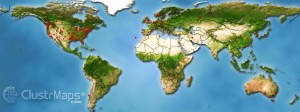Why would someone choose to add a ClusterMap to their website or blog instead of the ol’ standby of a visitor counter. You know the ones that look similar to your cars odometer.
There are several reasons I chose Clustermaps instead of a typical counter. First, I LOVE visuals and what better way to “see” your visitors than via world map. The map is great for not only seeing visitor locations but also their location is relation to yours.
Clustrmap also doesn’t count every single visit to your site. That, for me, is for Google Statistics. Clustrmaps instead counts unique visitors. Sure someone might visit your site from two computers and be counted twice, but that is better than if a person visits once a week for a year and is counted 52 times:)
Here are some additional benefits:
- Easy to install on a website, blog, etc.
- Has an additional live Clustrmap to allow you and/or your students to see who is currently looking at the blog.
- Archives yearly, so you don’t have one big red dot:)
Oh no! You loose the map? No it isn’t lost just archived. There is a link above you map for archives. Clustrmaps also sends you an email about the soon change. But you can have your own archive too such as saving the image to add to post just like this one. As this year starts to close, so does our 2009 Clustrmap.
Here is our archive for 2009:
 Take a look at these awesome visitors!!
Take a look at these awesome visitors!!
| United States (US) | 843 |
| Australia (AU) | 148 |
| Canada (CA) | 81 |
| Norway (NO) | 28 |
| United Kingdom (GB) | 26 |
| Germany (DE) | 14 |
| Russian Federation (RU) | 13 |
| Czech Republic (CZ) | 11 |
| France (FR) | 7 |
| Belgium (BE) | 5 |
| Netherlands (NL) | 5 |
| Switzerland (CH) | 4 |
| China (CN) | 4 |
| India (IN) | 4 |
| Finland (FI) | 3 |
| Spain (ES) | 3 |
| New Zealand (NZ) | 3 |
| Argentina (AR) | 3 |
| Korea, Republic of (KR) | 3 |
| Portugal (PT) | 3 |
| Philippines (PH) | 2 |
| Thailand (TH) | 2 |
| Serbia (RS) | 1 |
| Ireland (IE) | 1 |
| Sweden (SE) | 1 |
| Poland (PL) | 1 |
| Austria (AT) | 1 |
| Japan (JP) | 1 |
| Malaysia (MY) | 1 |
| Trinidad and Tobago (TT) | 1 |
| Indonesia (ID) | 1 |
| Peru (PE) | 1 |
| Chile (CL) | 1 |
| Brazil (BR) | 1 |
| Puerto Rico (PR) | 1 |
| Hong Kong (HK) | 1 |
| Italy (IT) | 1 |
| Macedonia (MK) | 1 |
| Greece (GR) | 1 |
| Iran, Islamic Republic of (IR) | 1 |
| Taiwan (TW) | 1 |
| Bulgaria (BG) | 1 |

 With the explosion of web 2.0 sites, it is sometimes hard to pick and choose sites most beneficial for you. When it comes to social bookmarking,
With the explosion of web 2.0 sites, it is sometimes hard to pick and choose sites most beneficial for you. When it comes to social bookmarking, 